♘امیرحسین♞
♘ مدیریت انجمن اسب ایران ♞
The Russian Trotter was developed by crossing the Orlov Trotter with the with the American Standardbred (American Trotter) and subsequent breeding inter se.
The crossbreeding began in the 1890s. Prior to 1914, 156 stallions and 220 purebred mares were used. After World War One and Civil War, the importation of American Trotters stopped; systematic activity began so as to improve the speed, conformation and the measurements of the crossbred. The goal was to find the best combination of these features. By 1950, the breed formation was completed. In 1960, in order to improve the breed's speed, a second crossing of Russian Trotters with American Standardbred stallions was made. The crossing still continues.
The modern Russian Trotter is a typical harness horse. Characteristically, it is generally clean and proportionately built and has well-developed muscles and tendons. The head is light, profile straight, neck long and straight, withers medium in height, back and loin straight and well muscled, croup flat, long and broad. In appearance the Russian Trotter is, however, inferior to the Orlov; it more frequently posses such defects as bowed legs or close hock-joints, drooping and short croup, exostoses and curb. The commonest colour are bay, black and chestnut; grey horses are less common. The average measurements (in cm) are: stallions - height at withers 161, oblique body length 163, chest girth 185, cannon bone girth 20.5; the mares' measurement are smaller: 159, 162, 184 and 19.8 respectively.
The speed of the Russian Trotter is quite high. The 1600 m trot record is 1 min 56.9 sec.
Twelve lines have been isolated in the breed.
Russian Trotters have adapted well to varied condition. Their distribution is broad, extending from the Baltic republics to western Siberia.
The breed's fertility is up to 75 foals per 100 mares. The life span averages 15-17 years. The highest longevity was displayed by the stallion Podarok (b. 1935) who founded a line, lived to be 29 and was used in mating up to the age of 28; and the mare Mazurka (b. 1954) who lived until 1980 and produced 16 foals.
As the percentage of the American Standardbred blood increases, three out of every four crossbreds display marked growth retardation, deteriorating conformation and dramatically reduced fertility. At the same time, the use of inbreeding against the background of crossbreeding causes no inbreeding depression even if the inbreeding coefficient is as high as 12%.
There are 1600 stud mares in the pedigree nucleus of the Russian Trotter. The total number of purebreds is as high as 27,000; there are some 290,000 crossbreds of various generations. The breed is bred in 27 studs, the best of them being Elan, Smolensk, Zlynsk, Alexandrov, and Dubrovski.
Studbooks are published regularly, with 23 volumes out so far. In the long term, pure breeding and corrective crossbreeding with the American Trotter are to be used.
The crossbreeding began in the 1890s. Prior to 1914, 156 stallions and 220 purebred mares were used. After World War One and Civil War, the importation of American Trotters stopped; systematic activity began so as to improve the speed, conformation and the measurements of the crossbred. The goal was to find the best combination of these features. By 1950, the breed formation was completed. In 1960, in order to improve the breed's speed, a second crossing of Russian Trotters with American Standardbred stallions was made. The crossing still continues.
The modern Russian Trotter is a typical harness horse. Characteristically, it is generally clean and proportionately built and has well-developed muscles and tendons. The head is light, profile straight, neck long and straight, withers medium in height, back and loin straight and well muscled, croup flat, long and broad. In appearance the Russian Trotter is, however, inferior to the Orlov; it more frequently posses such defects as bowed legs or close hock-joints, drooping and short croup, exostoses and curb. The commonest colour are bay, black and chestnut; grey horses are less common. The average measurements (in cm) are: stallions - height at withers 161, oblique body length 163, chest girth 185, cannon bone girth 20.5; the mares' measurement are smaller: 159, 162, 184 and 19.8 respectively.
The speed of the Russian Trotter is quite high. The 1600 m trot record is 1 min 56.9 sec.
Twelve lines have been isolated in the breed.
Russian Trotters have adapted well to varied condition. Their distribution is broad, extending from the Baltic republics to western Siberia.
The breed's fertility is up to 75 foals per 100 mares. The life span averages 15-17 years. The highest longevity was displayed by the stallion Podarok (b. 1935) who founded a line, lived to be 29 and was used in mating up to the age of 28; and the mare Mazurka (b. 1954) who lived until 1980 and produced 16 foals.
As the percentage of the American Standardbred blood increases, three out of every four crossbreds display marked growth retardation, deteriorating conformation and dramatically reduced fertility. At the same time, the use of inbreeding against the background of crossbreeding causes no inbreeding depression even if the inbreeding coefficient is as high as 12%.
There are 1600 stud mares in the pedigree nucleus of the Russian Trotter. The total number of purebreds is as high as 27,000; there are some 290,000 crossbreds of various generations. The breed is bred in 27 studs, the best of them being Elan, Smolensk, Zlynsk, Alexandrov, and Dubrovski.
Studbooks are published regularly, with 23 volumes out so far. In the long term, pure breeding and corrective crossbreeding with the American Trotter are to be used.


